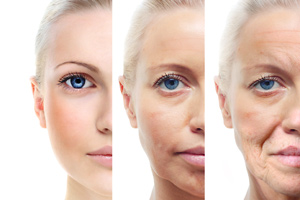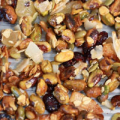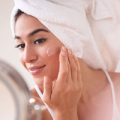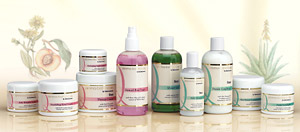Is Your Diet Aging You?
 Did you look in the mirror this morning and think, “Wow, I look great?” Or instead, did you glance in the glass and think, “When did I get so old?”
Did you look in the mirror this morning and think, “Wow, I look great?” Or instead, did you glance in the glass and think, “When did I get so old?”
If it was the latter, you might want to take a look at your refrigerator, kitchen cupboard, and dinner table for one of the culprits.
Aging happens to all of us, of course. There’s no way to put the brakes on it, no matter what the latest “nutraceuticals” may claim. But an unhealthy diet can send your aging process into overdrive, leaving you looking years older than your real age — and probably not doing the inside of your body any favors, either.
Quality Counts
“There’s an incredible amount of evidence that says that eating junk puts your body into an inflammatory state,” says Timothy Harlan, MD, assistant professor of medicine at Tulane University School of Medicine, a former restaurateur known as “Dr. Gourmet,” and author of Just Tell Me What to Eat!
“Poor-quality foods, like trans fats, cause inflammation – and aging is basically a chronic inflammatory state,” Harlan says. “Can you look older because you’re eating crap? Absolutely.”
For example, too much sugar and processed carbohydrates in the diet can lead to the production of what are called AGEs — advanced glycation end products. “These are associated with a number of diseases, like heart disease and diabetes, but they also damage the collagen and fibers of your skin,” says Andrea Giancoli, MPH, RD, a nutrition policy consultant for the California Center for Public Health Advocacy and a spokeswoman for the American Dietetic Association.
But it’s not just your looks that are on the line. Eating too much of foods that ramp up inflammation – or clog your arteries, or pack on extra pounds – can be bad news, from head to toe.
Foods to Limit
Here are five examples of foods that you may want to limit to stay as young as possible, inside and out:
- Potato chips and French fries. Really, anything that’s deep-fried in oil is laden with trans fats, which contribute to inflammation throughout your entire body. You should keep trans fats to less than 1% of your daily diet, says the American Heart Association.
- Doughnuts and sugary pastries. These pack a multiple whammy — often they’re high in trans fats and of course they’re packed with sugar, which is also linked with inflammation. And they produce those wrinkle-generating AGEs Giancoli talks about.
- Hot dogs, bacon, and pepperoni – any processed meats. Sad to say, the meats on your favorite home-delivery pizza and ballpark dogs aren’t doing you any favors. They’re high in saturated fats and also contain nitrates, both of which contribute to the inflammatory process.
- Less-than-lean red meats. The key with meat is to keep it lean to minimize saturated fats, which are big producers of inflammation and no friend of your arteries. The USDA’s 2010 dietary guidelines recommends eating a variety of protein foods, including lean meats. The American Heart Association suggests that you keep saturated fats from all sources (not just red meat) to less than 7% of your daily calorie intake.
- Alcohol. This is a tough one: Some alcohol may be good for you, but too much can absolutely age you prematurely. “Research says there’s a sweet spot for alcohol,” Harlan says. That’s one drink per day for women (such as a 5-ounce glass of wine or 12-ounce glass of beer) and two for men. If you drink, on average, one or two alcoholic drinks per day, that may be good for your heart. More than that, and you may be revving the aging process and its associated diseases like liver disease and certain cancers. If you don’t drink, health experts don’t advise you to start, and if you do drink, talk to your doctor to make sure your drinking is in line with your particular health concerns.
More importantly, Harlan says, eating a diet rich in high-quality foods can reduce inflammation, and help to keep you from looking your best. “It’s very clear that following a Mediterranean-style diet reduces the risk of a number of illnesses associated with aging, like cancer, Alzheimer’s, and heart disease.”
Foods to Favor
Harlan and Giancoli both reluctant to pick out a list of “superfoods” that help to keep you looking young and healthy. “There are people who have these theories that foods that are very high in antioxidants somehow slow the aging process, and there is some scant evidence of that in animal models,” Harlan says. “But don’t just pick out a few foods and focus on them. The minute you start talking about individual foods, people lose sight of the big picture.”
So stay away from fad diets that are all about salmon and acai berries, he says. “I want you to eat lots of broccoli and sweet potatoes and salmon and chickpeas and good-quality chicken. Eat a healthy variety of foods and that will keep you looking your best.”
That’s not just one opinion. In general, many sources are now saying that a traditional Mediterranean-style diet — rich in vegetables, fruits, whole grains, low-fat dairy, and lean protein — is your best option for overall health. Another important factor, Giancoli adds, is eating wholefoods, closest to their natural state as possible. “Don’t just eat plants, eat them pretty close to how they were when they came out of the ground or off the tree,” she says.
So instead of “superfoods,” here’s a list of five foods that are key elements of the Mediterranean diet, and are examples of the kinds of foods you need to be getting more of.
- Romaine lettuce. Plain old Romaine salad is high in vitamins A and C, antioxidant vitamins that help battle inflammation. Other dark leafy greens that should be on your list include broccoli, spinach, arugula, watercress, escarole, and endive.
- Tomatoes. Along with watermelon, grapefruit, guavas, asparagus, and red cabbage, tomatoes are particularly high in the antioxidant lycopene.
- Salmon. Along with other freshwater fish like tuna and herring, salmon is high in omega-3 fatty acids, which fight inflammation.
- Lentils. Beans are one of Harlan’s favorite sources of protein and are loaded with fiber and antioxidant vitamins. Try black beans, split peas, limas and pintos, and even fat-free refried beans. “Your skin is essentially made of protein, so if you don’t get enough healthy protein in your diet, your skin will reflect that,” Giancoli says. “Along with fish, beans are a great way to get it.”
- Oatmeal. Studies have found that whole grains such as oatmeal, whole wheat breads and pastas, brown rice, couscous, and quinoa help to reduce inflammation. “These also have B vitamins in them, like thiamine and riboflavin, which are important for skin as well,” Giancoli says. “Deficiencies in them causes rashes and scaly skin appearance.”
And you have to keep eating healthy to stay looking good. “Skin sloughs off all the time, so you need regular incoming doses of vitamins, nutrients, plant chemicals that we call phytonutrients, healthy fats, and proteins,” Giancoli says. “If you’re not getting enough of the good stuff on a regular basis, you won’t be able to produce healthy new skin cells in the way that you should.”
If you eat a diet like this, will you look better in the mirror? “That depends,” Harlan says. “I looked pretty ugly in the mirror before! But if you eat healthy, you are absolutely going to look better.”
Article source © Gina Shaw 2011 WebMD
































